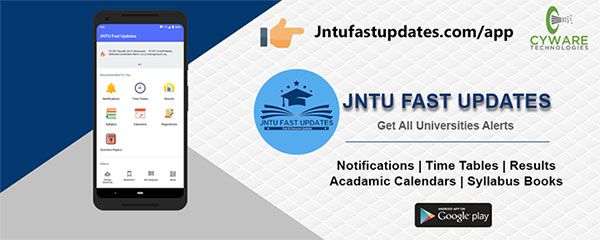JNTUK R20 2-1 RVSP Material/Notes PDF Download
Students those who are studying JNTUK R20 ECE Branch, Can Download Unit wise R20 2-1 Random Variables and Stochastic Processes (RVSP) Material / Notes / Test Books PDFs below.

JNTUK R20 2-1 RVSP Material/Notes PDF Download
Course Objectives: This course is designed to:
- To give students an introduction to elementary probability theory, in preparation to learn the concepts of statistical analysis, random variables and stochasticprocesses.
- To mathematically model the random phenomena with the help of probabilitytheory Concepts.
- To introduce the important concepts of random variables and stochasticprocesses.
- To analyze the LTI systems with stationary random process asinput.
UNIT-1
THE RANDOM VARIABLE: Introduction, Review of Probability Theory, Definition of a Random Variable, Conditions for a Function to be a Random Variable, Discrete, Continuous and Mixed Random Variables, Distribution and Density functions, Properties, Binomial, Poisson, Uniform, Gaussian, Exponential, Rayleigh, Conditional Distribution, Conditional Density, Properties.
Download UNIT-1 Material PDF | Reference-2
UNIT-2
OPERATION ON ONE RANDOM VARIABLE – EXPECTATIONS: Introduction, Expected Value of a Random Variable, Function of a Random Variable, Moments about the Origin, Central Moments, Variance and Skew, Chebychev’s Inequality, Characteristic Function, Moment Generating Function, Transformations of a Random Variable: Monotonic Transformations for a Continuous Random Variable, Non-monotonic Transformations of Continuous Random Variable.
Download UNIT-2 Material PDF | Reference-2
UNIT-3
MULTIPLE RANDOM VARIABLES: Vector Random Variables, Joint Distribution Function, Properties of Joint Distribution, Marginal Distribution Functions, Conditional Distribution and Density, Statistical Independence, Sum of Two Random Variables, Sum of Several Random Variables, Central Limit Theorem: Unequal Distribution, EqualDistributions.
OPERATIONS ON MULTIPLE RANDOM VARIABLES: Joint Moments about the Origin, Joint Central Moments, Joint Characteristic Functions, Jointly Gaussian Random Variables: Two Random Variables case, N Random Variables case, Properties, Transformations of Multiple Random Variables, Linear Transformations of Gaussian Random Variables.
Download UNIT-3 Material PDF | Reference-2
UNIT-4
RANDOM PROCESSES – TEMPORAL CHARACTERISTICS: The RandomProcess Concept, Classification of Processes, Deterministic and Nondeterministic Processes, Distribution and Density Functions, Concept of Stationarity and Statistical Independence. First-Order Stationary Processes, Second-order and Wide-Sense Stationarity, Nth -order and Strict-Sense Stationarity, Time Averages and Ergodicity, Autocorrelation Function and its Properties, CrossCorrelation Function and its Properties, Covariance Functions, Gaussian Random Processes, Poisson Random Process.
Download UNIT-4 Material PDF | Reference-2
UNIT-5
RANDOM PROCESSES – SPECTRAL CHARACTERISTICS: The PowerDensity Spectrum: Properties, Relationship between Power Density Spectrum and Autocorrelation Function, The Cross-Power Density Spectrum, Properties, Relationship between Cross-Power Density Spectrum and Cross-Correlation Function.
LINEAR SYSTEMS WITH RANDOM INPUTS: Random Signal Response of Linear Systems: System Response – Convolution, Mean and Mean-squared Value of System Response, Autocorrelation Function of Response, Cross-Correlation Functions of Input and Output, Spectral Characteristics of System Response: Power Density Spectrum of Response, CrossPower Density Spectra of Input and Output, Band pass, Band-Limited and Narrowband Processes, Properties.
Download UNIT-5 Material PDF | Reference-2
Text Books:
1. Probability, Random Variables & Random Signal Principles, Peyton Z. Peebles,TMH, 4th Edition, 2001.
2. Probability, Random Variables and Stochastic Processes, Athanasios Papoulisand S.Unnikrisha, PHI, 4th Edition, 2002.
3. Probability and Random Processes with Applications to Signal Processing, HenryStark and John W. Woods, Pearson Education, 3rdEdition, 2001.
Reference Books:
1. Schaum’s Outline of Probability, Random Variables, and Random Processes, 1997.
2. An Introduction to Random Signals and Communication Theory, B.P. Lathi, International Textbook, 1968.
3. Probability Theory and Random Processes, P. Ramesh Babu, McGrawHill, 2015.
Course Outcomes: After completion of the course, the student will be able to
- Mathematically model the random phenomena and solve simple probabilisticproblems.
- Identify different types of random variables and compute statistical averages ofthese randomvariables.
- Characterize the random processes in the time and frequencydomains.
- Analyze the LTI systems with randominputs.


320-x100(1).gif)

We want the most important questions
This is very useful n I thank uh so much